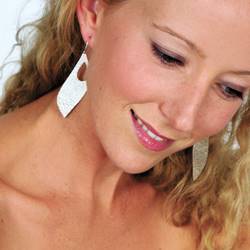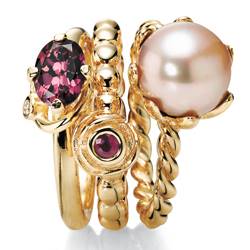Jewellery brands make their mark
 5.2 k views | By Bianca Mangion
5.2 k views | By Bianca Mangion
Brands have given the jewellery industry a well-needed burst of life - fuelling consumer desire, and changing retailer mind sets. BIANCA MANGION tracks the new phenomenon.
It's undeniable: branding has made an indelible impression on both supply and retail throughout the country. Across the spectrum from high to mid-range, jewellery customers hungry for labels now receive their purchases in the impressive packaging each piece deserves, stamped with the same logos plastered across the pages of glossy fashion magazines and huge posters on store facades.
Complimenting this, forward-thinking brands are rolling out websites that celebrate new ranges - up to every six months to keep appetites alive - and loudly proclaiming even the mildest of celebrity endorsements.
Yet, it wasn't so long ago that branded jewellery suppliers were met with hesitation from prospective retail stockists who preferred the tried-and-true safety of generic staple items, but persistence has paid-off and today, brands have changed the way retailers and consumers see fashion and fine jewellery, and they've become the most effective way to market.
At least, that's the viewpoint of Gary O'Brien, Surreal Jewellery marketing manager: "Consumers are trained to react to brands and can respond more positively to advertising and PR campaigns for a branded experience rather than a non-branded experience."
Surreal is a high-end gold charm brand, predominantly crafted in Australia. The range of 350 charms is designed to compliment Surreal bracelets and necklaces, stylish enough to be worn with or without the embellishments.
Nils Rasmussen, director of Edge of Sweden supplier Jarass, agrees that the boom in branded jewellery shows a change in retailer attitudes.
"The proliferation of branded jewellery we see now is a result of retailers acknowledging the value and security-branded merchandise can add to a business," he says. "The future of retailing is all about brands, and in the jewellery industry this used to only be true of the watch business."
Indeed, emphasising this growth, brands are focusing not only on fine jewellery but the fashion sector of the market also.
"Branding recognition at an affordable price point has become a much more significant issue," says Phil Edwards, director of Thomas Sabo, distributed by DGA. "In the past, you had branded jewellery at the higher-end - Tiffany's or Bulgari, for example - and then you had the very cheap Diva and Klein's brands. But you didn't have something that was affordable for the everyday wearer, while also being something people aspired to."
Brands have become much more important to the average consumer, Edwards continues: "People can see it; they recognise it as a brand and they recognise it as fashion, quality and value. That's where branding has become very important, at the affordable level."
On the other end of the price range, some brands are aiming high. Martin Glisby is managing director of Ole Lynggaard Asia Pacific. He says the newcomer to Australia - Ole Lynggaard Copenhagen (OLC) - has been a popular brand name and concept for over 40 years in the high-end jewellery market in Scandinavia.
"Whereas other brands have clearly revolutionised the middle segment of the Australian jewellery market by introducing a strong and successful brand concept, OLC is targeting the high segment of the market," Glisby says.
Since hitting these shores, Glisby has noted an increasing focus on brands and brand concepts but this focus was not always as clear as it is now. Newcomers like Ole Lynggaard have debuted to a brand-friendly market, but Australian jewellery's brand pioneers had a tough slog trying to entice retailers to adopt a brand in their stores.
"The first challenge was convincing jewellers to take branded merchandise," reflects O'Brien. "Many of them have long-standing relationships with suppliers of non-branded merchandise, and branded merchandise can be a bit more expensive."

Renee Blackwell Design
The extra cost of branded products comes from the investment brands make in advertising and PR - essential elements in building a brand and communicating its message. But there are many benefits for retailers behind this.
"We try to encourage jewellers to leverage off our marketing in their store - to build on what we're doing. We're certainly seeing a response to that strategy," says O'Brien. "Many of the jewellers are prominently advertising our product in their store and in their advertising campaigns, capitalising on the awareness of the Surreal product. Rather than jewellers promoting their own product - a generic ring or jewellery - they are starting to recognise there's excellent value promoting a branded product because there's (already) awareness in the marketplace."
And consumers have responded accordingly. O'Brien reports that some Surreal customers have actually pulled ads out of magazines and brought them into the store to place an order.
"Sometimes this has involved jewellers not already stocking Surreal Jewellery, creating a new account with us, and, consequently, more business for themselves."
This response is a result of much time spent educating retailers about how to stock brands.
Edwards calls this education process "brand awareness" and says it starts with the retailer: "Brand awareness is over many levels and one of the first is educating the retailer on how to make space in a store to display the brand. How do you create the space? In some cases where retailers do not understand the power and success of international brands, it's a definite challenge. When you go to introduce a brand, retailers will say, 'Yeah it looks great but where am I going to put it, or how am I going to afford it?' There are many hurdles that, once addressed, can lead to fantastic results."
When retailers are educated, it builds their confidence in the brand - a factor that often leads to ongoing success, according to Chris Barry, director, Chamilia Jewellery.
"Demonstrating that there is a quality alternative in a competitive market and that our brand will only enhance the range and benefit the business was something we found challenging initially," Barry says. "We had to communicate that adding Chamilia would increase customer traffic and bring repeat business in their store."
This communication and spreading of brand awareness starts with the retailer, and ends with the consumer. Creating awareness of a new brand and projecting its message to the end user is tricky, yet a crucial part of the process.
"We must focus on communicating what the brand stands for - for example, how many hours of traditional craftsmanship that goldsmiths in Denmark put into the production of OLC jewellery," Glisby says. "In Scandinavia, people never question our prices because they know and understand our full brand concept. The real challenge in a new market is to make people emotionally 'feel' what the brand is all about."
Even after a brand's message has been initially absorbed by its market, brand awareness is an ongoing responsibility for the supplier and retailer.
"The concept of educating consumers never ends," Edwards says. "We just have to constantly communicate, inform and educate - whether it be about the brand or about the product. Education involves brand recognition, then product association - when a customer wears something and it gets recognised as a Thomas Sabo piece. The next tier of education is continually letting customers know what's new, what's next for the brand."
Edwards says knowing how to advertise is not as simple as it seems. The distributor and retailer must consider the best approach on how to reach the consumer and be noticed. Experiencing success with mass advertising, Thomas Sabo is now sending targeted consumer emails to those with an expressed interest in the brand.

Pandora
"Its not like we've just got a database," Edwards explains. "It's actually of people who have said they want to be kept informed on Thomas Sabo. Consumers love to be informed."
The more informed customers are on new product, the stronger their desire to buy more. Share of mind equals share of market, so keeping fresh in the consumer's mind is paramount to a successful brand. And it appears branded suppliers know this all too well.
"It really is a major change in the industry: in the past, people would go shopping to buy a ring or buy a present. Now they are being driven by the product. They see it and they want it. They may not have a particular need to buy the jewellery, but because that desire has been created, they buy anyway," O'Brien says.
Communication aside, O'Brien believes continuous repurchases also come from the nature of Surreal (and many other) products. With 350 charms in the Surreal range, the collection offers enough variety to be considered collectable, thus keeping customers coming back for more, time after time.
"This also gives the jeweller the opportunity to sell these customers other products in their store," he says.
Charms have dominated the branded jewellery market up until recently. Well-received by Australian consumers who relished the idea of the "modern-day charm bracelet", these tiny trinkets were used by many suppliers to ease their brand into the market. Now, well-established, brands are beginning to introduce branded jewellery across all categories. "We focused on Thomas Sabo charms initially and then we evolved to the sterling silver jewellery once we had established brand awareness, and had some space in a retail shop," Edwards says. "Retailers know the charms have worked and understand the power of the brand, so they ask what's next. They want to evolve and grow with the brand."
And this goes for customers, too.
"Those customers who have become greatly devoted to the charms, then turn around and realise there's now this whole jewellery collection on offer. And they are already quite brand loyal as well," Edwards says.
These collections will keep expanding, too, with suppliers already flagging exciting plans for fresh product directions. Sterling silver brand Edge of Sweden will extend its collection into fine jewellery, with the use of white gold and diamonds, while the already high-end OLC will introduce more of its trademark Sweet Drops charms with new bracelet colours. The Sweet Drops bracelet concept will also develop into other jewellery categories including rings, pendants and earrings; while a men's version may also be in the pipeline.
This is just the tip of the iceberg, with hundreds of global jewellery brands driving the growth of the branded sector by producing new lines with alarming frequency.
"This is the future of the jewellery industry. It's changing, and those who don't change will be left behind," says O'Brien. "Retailers devoting prominent space in their shop to branded items are the ones moving forward as they realise customers come in more frequently for branded items. Branded products also attract new customers. The smart jewellers will take the initiative and work with the brand, asking, 'What can you offer me to make my store look better and increase my sales?' Jewellery is glamorous and the stores can reinforce this by using material from branded products."
Brands have pumped jewellery with many values - not only glamour, but sexiness, excitement and fashion. As the number of customers who want to be affiliated with these values rises, it's clear that the only way is up for branded jewellery.
Posted June 01, 2009